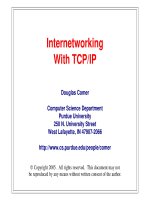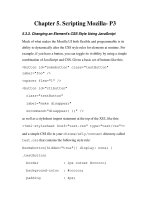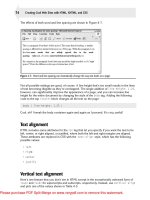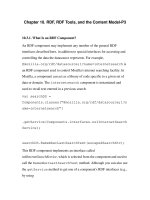Internetworking with TCP/IP- P3 doc
Bạn đang xem bản rút gọn của tài liệu. Xem và tải ngay bản đầy đủ của tài liệu tại đây (417.67 KB, 10 trang )
Contents
xix
Chapter 26 Applications: File Transfer And Access (FTP, TFTP, NFS)
497
Introduction
497
File Access And Transfer
497
On-line Shared Access
498
Sharing By File Transfer
499
FTP:
The Major TCPIIP File Transfer Protocol
499
FTP Features
500
FTP Process Model
500
TCP Port Number Assignment
502
The User's View Of FTP
502
An Example Anonymous FTP Session
504
TFTP
505
NFS
507
NFS Implementation
507
Remote Procedure Call (RPC)
508
Summary
509
Chapter 27 Applications: Electronic Mail (SMTP, POP, IMAP, MIME)
511
27.1 Introduction
5 1
1
27.2 Electronic Mail
5 1 1
27.3 Mailbox Names And Aliases
5 13
27.4 Alias Expansion And Mail Forwarding
5 13
27.5 The Relationship Of Internetworking And Mail
514
27.6 TCPIIP Standards For Electronic Mail Service
5 16
27.7 Electronic Mail Addresses
5 16
27.8 Pseudo Domain Addresses
5 18
27.9 Simple Mail Transfer Protocol (SMTP)
518
27.10 Mail Retrieval And Mailbox Manipulation Protocols
27.1 1 The MIME Extension For Non-ASCII Data
522
27.12 MIME Multipart Messages
523
27.13 Summary
524
Chapter 28 Applications: World Wide Web (HTTP)
28.1 Introduction
527
28.2 Importance Of The Web
527
28.3 Architectural Components
528
28.4 Uniform Resource Locators
528
28.5 An Example Document
529
28.6 Hypertext Transfer Protocol
530
28.7 HTTP GET Request
530
28.8 Error Messages
53
1
28.9 Persistent Connections And Lengths
532
28.10 Data Length And Program Output
532
28.11 Length Encoding And Headers
533
28.12 Negotiation
534
28.13 Conditional Requests
535
28.14 Support For Proxy Servers
535
28.15 Caching
536
28.16 Summary
537
Chapter
29
Applications: Voice And Video Over IP
(RTP)
Introduction
539
Audio Clips And Encoding Standards
539
Audio And Video Transmission And Reproduction
540
Jitter And Playback Delay
541
Real-Time Transport Protocol (RTP)
542
Streams, Mixing, And Multicasting
543
RTP Encapsulation
544
RTP Control Protocol (RTCP)
544
RTCP Operation
545
IP Telephony And Signaling
546
Resource Reservation And Quality Of Service
548
QoS, Utilization, And Capacity
549
RSVP
549
COPS
550
Summary
551
Chapter
30
Applications: Internet Management (SNMP)
Introduction
553
The Level Of Management Protocols
553
Architectural Model
554
Protocol Framework
556
Examples of MlB Variables
557
The Structure Of Management Information
558
Formal Definitions Using ASN.1
559
Structure And Representation Of MIB Object Names
559
Simple Network Management Protocol
564
SNMP Message Format
566
Example Encoded SNMP Message
569
Contents
30.12 New Features In SNMPv3
572
30.13 Summary
572
Chapter
31
Summary
Of
Protocol Dependencies
31.1 Introduction
575
31.2 Protocol Dependencies
575
31.3 The Hourglass Model
577
31.4 Application Program Access
578
31.5 Summary
579
Chapter
32
Internet Security And Firewall Design (IPsec)
32.1 Introduction
58 1
32.2 Protecting Resources
582
32.3 Information Policy
583
32.4 Internet Security
583
32.5 IP Security (IPsec)
584
32.6 IPsec Authentication Header
5 84
32.7 Security Association
585
32.8 IPsec Encapsulating Security Payload
586
32.9 Authentication And Mutable Header Fields
587
32.10 ZPsec Tunneling
588
32.11 Required Security Algorithms
588
32.12 Secure Sockets
589
32.13 Firewalls And Internet Access
589
32.14 Multiple Connections And Weakest Links
589
32.15 Firewall Implementation
590
32.16 Packet-Level Filters
590
32.1 7 Security And Packet Filter Specification
591
32.18 The Consequence Of Restricted Access For Clients
592
32.19 Proxy Access Through A Firewall
592
32.20 The Details
Of
Firewall Architecture
593
32.21 Stub Network
594
32.22 An Alternative Firewall Implementation
595
32.23 Monitoring And Logging
596
32.24 Summary
596
xxii
Chapter 33 The Future
Of
TCPnP (IPv6)
Contents
599
33.1 Introduction
599
33.2 Why Change?
600
33.3 New Policies
600
33.4 Motivation For Changing IPv4
600
33.5 The Road To A New Version Of IP
601
33.6 The Name Of The Next IP
602
33.7 Features Of IPv6
602
33.8 General Form Of An IPv6 Datagram
603
33.9 IPv6 Base Header Format
603
33.10 IPv6 Extension Headers
605
33.11 Parsing An IPv6 Datagram
606
33.12 IPv6 Fragmentation And Reassembly
607
33.13 The Consequence Of End-To-End Fragmentation
607
33.14 IPv6 Source Routing
608
33.15 IPv6 Options
609
33.16 Size Of The IPv6 Address Space
610
33.1
7
IPv6 Colon Hexadecimal Notation
6 10
33.18 Three Basic IPv6 Address Types
61 2
33.19 The Duality Of Broadcast And Multicast
612
33.20 An Engineering Choice And Simulated Broadcast
613
33.21 Proposed IPv6 Address Space Assignment
613
33.22 Embedded IPv4 Addresses And Transition
614
33.23 Unspecified And Loopback Addresses
616
33.24 Unicast Address Hierarchy
61 6
33.25 Aggregatable Global Unicast Address Structure
617
33.26 Intelfoce Identifiers
6 18
33.2
7
Additional Hierarchy
6 19
33.28 Local Addresses
6 19
33.29 Autoconfiguration And Renumbering
620
33.30 Summary
620
Appendix
1
A Guide To RFCs 623
Appendix
2
Glossary
Of
Internetworking Terms And Abbreviations 673
Bibliography
721
Index
729
Foreword
This is the fourth edition of a landmark book, the book that signaled the coming of
age of the Internet. Development of the protocols for the Internet started around 1974,
and they had been in limited but real use starting in the early 80's, but as of 1987,
there was still no good introduction to how they worked or how to code them. The
standards documents for TCP, IP and the other protocols existed, of course, but the true
truth
-
the collection of knowledge and wisdom necessary to implement a protocol
stack and actually expect it to work
-
that was a mystery, known only to a small band
of the initiated. That was not a good thing, and the initiated knew it. But it takes a lot
of effort to pull all the right stuff together and write it down. We waited, knowing that
a good book explaining TCP/IP would be an important step towards the broad accep-
tance of our protocols.
And Doug wrote the book.
We told jokes, waiting for the book. We looked to see how many books there
were in mature fields, and speculated that the number of books was a metric of success.
I actually went and looked to see how many books there were on "how to build a com-
piler" (a post-mature field by now, perhaps
-
time to count the books again). The
compiler community was well off, and even "how to build a database" was available.
But nothing on "how to build a TCP/IP." And then we got our book.
Of course, knowing that back then this was a landmark book is not enough to
make you buy it. Collectors might want to
find the fist edition, but that gives the true
truth as of 12 years ago, a long time in Internet years. And that is why this is the fourth
edition.
A
lot has changed over that time. We have learned a lot more, the field has
grown up, whole new protocols have emerged, and Doug has rewritten the book three
times. That is a measure both of how much and how fast the field changes, and how
much work must go into keeping this book current. It has all the new stuff, and our
best current knowledge about all the old stuff.
Other things have changed in 12 years. Not only has the Internet grown up, but
some of our heroes have grown old, and some have died. The foreword to the first edi-
tion was written by Jon
Postel, one of the true Internet pioneers, who died in the fall of
1998. Below, we have reprinted the foreword he wrote for the first edition. Much is
the same, but much has changed. This is still a very readable book both for details on
TCP/IP and for an introduction to communications protocols in general. But in 1987,
Jon wrote "Computer communication systems and networks are currently separated and
xxiv
Foreword
fragmented. The goal of interconnection and internetworking, to have a single powerful
computer communication network, is fundamental to the design of TCP/IP." Only
12
years ago networks were fragmented; today the Internet unites the world. And TCPD
is still the glue, at the core of the Internet, that makes all this work. And this is still the
book to read to learn about it.
David Clark
Massachusetts Institute of Technology
December,
1999
Foreword To The First Edition
By
The Late Jon Postel
In
this book Professor Douglas Comer has provided a long sought overview and
introduction to TCP/IP. There have been many requests for "the" article, report, or
book to read to get started on understanding the
TCP/IP protocols. At last, this book
satisfies those requests. Writing an introduction to TCP/IP for the uninitiated is a very
difficult task. While combining the explanation of the general principles of computer
communication with the specific examples from the
TCP/IP protocol suite, Doug Comer
has provided a very readable book.
While this book is specifically about the TCPm protocol suite, it is a good book
for learning about computer communications protocols in general. The principles of ar-
chitecture, layering, multiplexing, encapsulation, addressing and address mapping, rout-
ing, and naming are quite similar in any protocol suite, though, of course, different in
detail (See Chapters
3,
10, 17, and 18)t. Computer communication protocols do not do
anything themselves. Like operating systems, they are in the service of applications
processes. Processes are the active elements that request communication and are the ul-
timate senders and receivers of the data transmitted. The various layers of protocols are
like the various layers in a computer operating system, especially the file system.
Understanding protocol architecture is like understanding operating system architecture.
In
this
book Doug Comer has taken the "bottom up" approach
-
starting with the
physical networks and moving up
in
levels of abstraction to the applications.
Since application processes are the active elements using the communication sup-
ported by the protocols, TCP/IP is an "interprocess communication"
(PC)
mechanism.
While there are several experiments in progress with operating system style message
passing and procedure call types of
IPC based on
IP,
the focus in this book is on more
traditional applications that use the
UDP
datagram or TCP logical connection forms of
IPC
(See
Chapters 11, 12,
17,
18, and
19).
One of the key ideas inherent in TCP/IP and in the title of this book is "internet-
working." The power of a communication system is directly related to the number of
entities in that system. The telephone network is very useful because (nearly) all of the
+Editor's
note:
chapter
numbers have changed since the first edition.
xxvi
Foreword To
The
Fit
Edition
telephones are in (as it appears to the users) one network. Computer communication
systems and networks are currently separated and fragmented. The goal of interconnec-
tion and internetworking, to have a single powerful computer communication network,
is fundamental to the design of TCPIIP. Essential to internetworking is addressing (See
Chapters 4,
5,
and 6), and a universal protocol
-
the Internet Protocol (See Chapters 7,
8, and 9).
To have an internetwork the individual networks must be connected. The connect-
ing devices are called gateways. Further, these gateways must have some procedures
for forwarding data from one network to the next. The data is in the form of
IP
da-
tagrams and the destination is specified by an
IP
address, but the gateway must make a
routing decision based on the
IP
address and what it knows about the connectivity of
the networks making up the Internet. The procedures for distributing-the current con-
nectivity information to the gateways are called routing algorithms, and these are
currently the subject of much study and development (See Chapters
13,
14,
15,
and 16).
Like all communication systems, the TCP/IP protocol suite is an unfinished sys-
tem.
It is evolving to meet changing requirements and new opportunities. Thus, this
book is, in a sense, a snapshot of
TCP/IP circa 1987. And, as Doug Comer points out,
there are many loose ends (See Chapter
20).
Most chapters end with a few pointers to material "for further study." Many of
these refer to memos of the
RFC
series of notes.
This series of notes is the result of a
policy of making the working ideas and the protocol specifications developed by the
TCP/IP research and development community widely available. This availability of the
basic and detailed information about these protocols, and the availability of the early
implementations of them, has had much to do with their current widespread use. This
commitment to public documentation at this level of detail is unusual for a research ef-
fort, and has had significant benefits for the development of computer communication
(See Appendix
3).
This book brings together information about the various parts of the TCP/IP archi-
tecture and protocols and makes it accessible. Its publication is a very significant rnile-
stone in the evolution of computer communications.
Jon Postel,
Internet Protocol Designer and
Deputy Internet Architect
December, 1987
The explosive growth of the Internet continues. When the third edition of this
book was written five years ago, the Internet connected
4.8
million computers, up from
5,000
when the first edition was published. The Internet now reaches over
56
million
computers, meaning that the 1995 Internet was only about
8%
of its current size. Dur-
ing the early 1990s, those of us who were involved with the Internet marveled at how
large an obscure research project had become. Now, it pervades almost every aspect of
society.
TCPD has accommodated change well. The basic technology has survived nearly
two decades of exponential growth and the associated increases in traffic. The proto-
cols have worked over new high-speed network technologies, and the design has han-
dled applications that could not be imagined in the original design.
Of
course, the en-
tire protocol suite has not remained static. New protocols have been deployed, and new
techniques have been developed to adapt existing protocols to new network technolo-
gies.
This edition contains updated information throughout the text as well as new ma-
terial that describes technical advances and changes. For example, because classless ad-
dressing has become widely deployed, the description of IP forwarding examines tech-
niques for classless lookup. In addition, the chapters on
IP
describe the Differentiated
Services (DiffServe) scheme for classes of service
as
well as path
MTU
discovery and
anonymous networks. The chapter on TCP describes Random Early Drop (RED). The
chapter on exterior routing has been updated to use BGP as the primary example. The
descriptions of protocols such as
RIP,
IGMP, SNMP, and
IPv6
have been revised to in-
corporate new versions and recent changes. Finally, the chapter on security discusses
IPsec.
Four new chapters contain detailed infornlation about significant developments.
Chapter 19 describes mobile IP
-
a technology that allows a computer to move from
one network to another without changing its
IP
address. Chapter 20 considers two tech-
nologies used to interconnect private intranets and the global Internet: Virtual Private
Network (VPN) and Network Address Translation (NAT). Each solves a slightly dif-
ferent problem; both are widely deployed. Chapter
28
covers the
HTML
and
I-ITTP
protocols that form the basis for the most significant Internet application: the world
wide web. Chapter 29 focuses on an exciting new area: sending real-time data such
as
xxviii
Preface
voice and video over an IP network. The chapter examines the RTP protocol that al-
lows a receiver to coordinate and play such data as well as the RSVP and COPS proto-
cols that can be used to provide resource reservation, and describes the
H.323
suite of
protocols used for
IP
telephony.
The fourth edition retains the same general contents and overall organization as the
third edition. The entire text focuses on the concept of
internetworking in general and
the TCP/IP internet technology in particular. Internetworking is a powerful abstraction
that allows us to deal with the complexity of multiple underlying communication tech-
nologies. It hides the details of network hardware and provides
a
high level communi-
cation environment. The text reviews both the architecture of network interconnections
and the principles underlying protocols that make such interconnected networks function
as a single, unified communication system. It also shows how an internet communica-
tion system can
be
used for distributed computation.
After reading this book, you will understand how it is possible to interconnect mul-
tiple physical networks into a coordinated system, how internet protocols operate in that
environment, and how application programs use the resulting system. As a specific ex-
ample, you will
learn the details of the global TCP/IP Internet, including the architec-
ture of its router system and the application protocols it supports. In addition, you will
understand some of the limitations of the internet approach.
Designed as both a college text and as a professional reference, the book is written
at an advanced undergraduate or graduate level. For professionals, the book provides a
comprehensive introduction to the
TCPD technology and the architecture of the Inter-
net. Although it is not intended to replace protocol standards, the book is an excellent
starting point for learning about internetworking because it provides a uniform overview
that emphasizes principles. Moreover, it gives the reader perspective that can be ex-
tremely difficult to obtain from individual protocol documents.
When used in the classroom, the text provides more than sufficient material for a
single semester network course at either the undergraduate or graduate level. Such a
course can be extended to a two-semester sequence
if
accompanied by programming
projects and readings from the literature. For undergraduate courses, many of the de-
tails are unnecessary. Students should
be
expected to grasp the basic concepts
described in the text, and they should be able to describe or use them. At the graduate
level, students should be expected to use the material as a basis for further exploration.
They should understand the details well enough to answer exercises or solve problems
that require them to explore extensions and subtleties. Many of the exercises suggest
such subtleties; solving them often requires students to read protocol standards and ap-
ply creative energy to comprehend consequences.
At all levels, hands-on experience sharpens the concepts and helps students gain
intuition. Thus, I encourage instructors to invent projects that force students to use In-
ternet services and protocols. The semester project in my graduate Internetworking
course at Purdue requires students to build an
IP
router. We supply hardware and the
source code for an operating system, including device drivers for network interfaces;
students build a
working router that interconnects three networks with different MTUs.
The course is extremely rigorous, students work in teams, and the results have been im-









